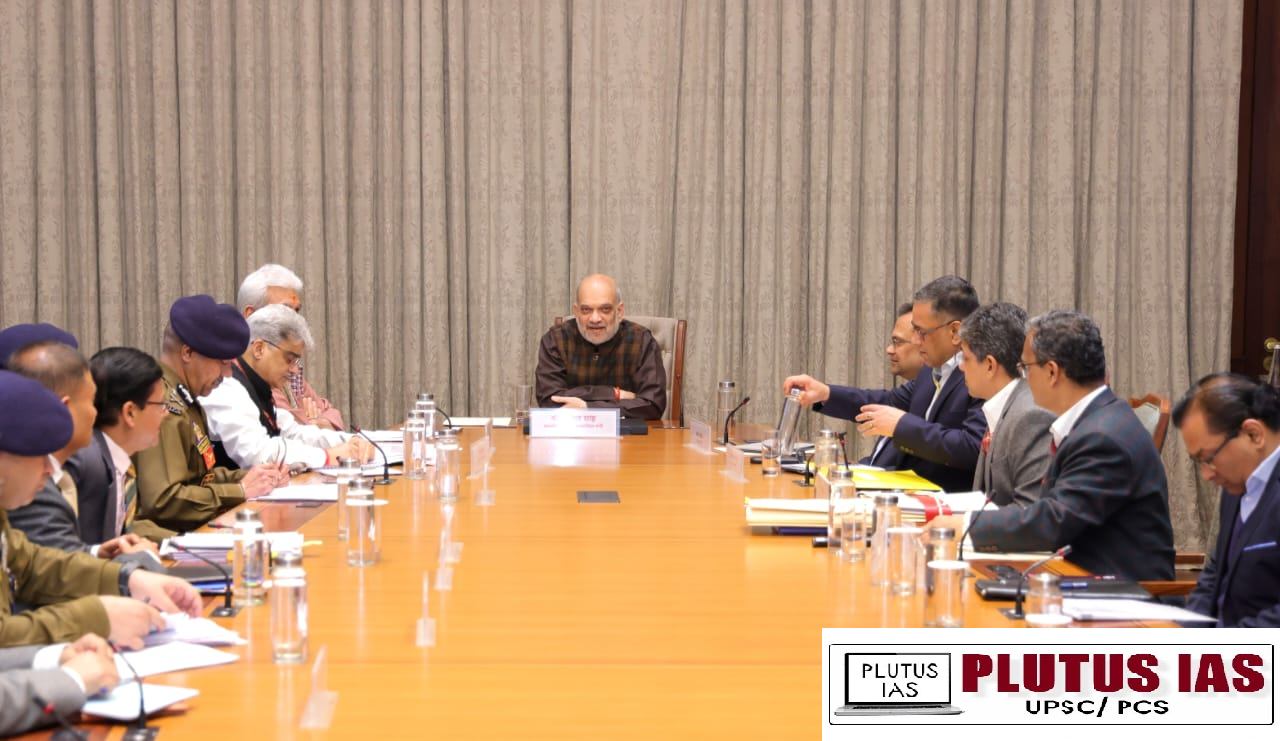08 Feb Unique Security Challenges in Border Areas
SYLLABUS MAPPING:
GS-3- Internal Security-Unique Security Challenges in Border Areas
FOR PRELIMS
What is the National Security Council and its rule? NSA and its rule, What is an operation Sadbhavana.
FOR MAINS
Why in the news?
Union Home Minister and Minister of Cooperation, Shri Amit Shah, chaired a high-level review meeting in New Delhi on the security situation in Jammu and Kashmir. The meeting, attended by key officials including Jammu and Kashmir’s Lieutenant Governor Shri Manoj Sinha and top officials from the Ministry of Home Affairs and the Jammu and Kashmir administration, discussed strategies to combat terrorism in the region. Shri Amit Shah emphasized the government’s commitment, under Prime Minister Narendra Modi’s leadership, to completely eradicate terrorism in Jammu and Kashmir. He directed security agencies to intensify efforts and set a “zero infiltration” goal while focusing on a ruthless approach towards terrorism and infiltration.
India Border and Security:
1. Cross-Border Terrorism: Infiltration by terrorist groups, especially from Pakistan and Bangladesh, remains a major threat.
2. Smuggling & Illegal Immigration: Porous borders facilitate arms, drugs, and human trafficking, threatening security.
3. Border Disputes: Ongoing territorial disputes, particularly with China and Pakistan, create tensions.
4. Infiltration & Espionage: Cross-border espionage and intelligence gathering pose serious risks.
5. Ethnic & Political Instability: Insurgencies and separatist movements complicate security in border regions.
6. Technological & Cyber Threats: Advanced technology like drones and cyberattacks challenge border defence systems.
7. Lack of Infrastructure: Remote areas lack roads, surveillance, and communication, hindering security efforts.
8. Climate & Natural Disasters: Harsh climates and disasters like floods complicate border management.
9. International Relations: Diplomatic tensions with neighbouring countries affect border security cooperation.
10. Resource Constraints: Limited manpower and funds stretch border security forces thin.
Unique Challenges to Internal Security in Jammu Kashmir:
1. Cross-border Terrorism: Militant groups, especially from Pakistan, infiltrate the region to carry out attacks, creating ongoing security threats.
2. Separatist Sentiment: A significant portion of the Kashmiri population desires an independent Kashmir, fueling protests and unrest.
3. Social Media Manipulation: Misinformation spreads on social media, exacerbating tensions and inciting violence.
4. Narco-terrorism: Drug trafficking funds terrorist activities, complicating the security environment.
5. Difficult Terrain: The region’s mountainous geography makes surveillance and security operations difficult.
6. Human Rights Concerns: Allegations of human rights abuses by security forces alienate the local population.
7. Political Instability: Shifting government policies regarding Kashmir creates confusion and uncertainty among the people.
Way to improve Border security:
1. Increase Cooperation:
Coordinate Agencies: Enhance communication between local authorities and border agencies.
Build Capacity: Train officials to handle common border security challenges.
Facilitate Cooperation: Promote collaboration at interagency, intra-service, and international levels.
2. Improve Technology:
Biometric Identification: Use fingerprint, iris scanners, and facial recognition for border identification.
Surveillance Systems: Deploy telecom fiber for monitoring and detecting unauthorized activities.
Floodlighting: Illuminate border areas for improved visibility and security.
3. Raise Awareness:
Reduce False Documents: Enhance technology and public awareness to limit counterfeit documents.
4. Economic and Social Development:
Trade and Relations: Foster border community involvement in trade and diplomatic relations.
Border Area Development: Focus on infrastructure and social development in border regions.
Download Plutus IAS Current Affairs (Eng) 08th Feb 2025
Conclusion:
Border security is crucial for maintaining national sovereignty and stability. Challenges such as cross-border terrorism, smuggling, territorial disputes, and technological threats demand a multi-pronged approach. Increased cooperation between agencies, advanced technologies like biometric identification and surveillance systems, and raising public awareness can help mitigate these challenges. Additionally, economic development and infrastructure improvements in border areas are essential for enhancing security and fostering positive relations with neighbouring countries. Strategic, coordinated efforts are needed to ensure India’s borders remain secure and protected.
Prelims Questions:
Q. With reference to the Border Security Forces in India, consider the following statements:
1. The Border Security Force (BSF) was established in 1965 to protect India’s land borders.
2. The Indo-Tibetan Border Police (ITBP) is responsible for securing India’s borders with Nepal and Bhutan.
3. The National Security Guard (NSG) specializes in counter-terrorism operations and has a significant role in bomb disposal and hostage rescue.
How many of the above-given statements are correct?
A. Only one
B. Only two
C. All three
D. None
Answer: B
Mains Questions:
(250 words, 15 marks)





No Comments